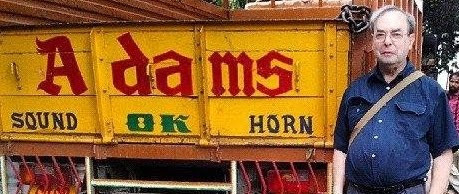Chinese fishing nets, Fort Cochin
Goat on a boat: on the ferry from Vypin to Fort Cochin
Like Venice and Istanbul,
Cochin is a city where water plays an important role both functionally and
aesthetically. The Cochin ‘metropolitan’ area that includes Fort Cochin,
Mattancherry, the modern city of Ernakulam, Willingdon Island, and other
islands is infiltrated with waterways that flow past them and out into the
Arabian Sea. These watery channels are alive with shipping, lined with
fishermen, flanked by warehouses, and swarming with waterfowl. The sun reflects
off the waters, producing a rare quality of light that heightens the beauty of
the area.
The historic city of Fort
Cochin with its many historic buildings, its Chinese fishing nets, and its
colourful shoreline, makes for a wonderful place for tourists to linger. I have
visited the place three times in two years, and Cochin’s attraction simply
continues to grow for me.
The elongated island of Vypin
(aka ‘Vypeen’) runs in a north-south direction, its southernmost tip being
across the estuary from Fort Cochin. Two ferries connect Vypin with Fort
Cochin. One carries foot passengers only, and the other carries both vehicles
and foot passengers.
Ticket office for ferry at Vypin
The first time that I crossed
to Vypin on the foot passenger only ferry, I noticed that a section of the boat
was reserved for ladies only. Indeed, the queues for the ticket boot were
segregated by gender. Lately (2017), I did not notice any separation of male
and female passengers.
Leaving Fort Cochin, the ferry
passenger gets a good view of the Chinese fishing nets on one side, and of the waterfronts
of the Brunton Boat House and its neighbours (such as the old Aspinwall
warehouse complex).
The ferry captains have to
navigate carefully, so as to avoid colliding with all manner of craft:
everything from ocean going liners and enormous dredgers to tourist pleasure
boats and smaller craft used by the local fishermen.
Boats moored at Vypin
As the Fort Cochin shore
begins to recede and mingle with the heat haze, the Chinese fishing nets of
Vypin get nearer. Behind them, it is not difficult to see a couple of huge
cylindrical structures, which are part of an oil refining site near to the
Arabian Sea shore.
Belts in a small shop in Vypin
Both ferries dock at the aged,
rather shabby Vypin ferry terminal, which until recently contained an even
shabbier café, The Sealand, now closed. Passing through the terminal, we reach
a line of small shops that face a parking area where multi-coloured busses and
auto-rickshaws park. These busses carry passengers to a variety of places
including Ernakulam and beaches at the northern tip of the island.
Detail on a private house in Vypin
The southern shore of Vypin is
a peaceful contrast to the relatively busy shore of Fort Cochin, which faces it
across the water. A good paved footpath follows the shoreline, passing several
Chinese fishing net set-ups, upon whose ropes and wooden structural elements
sea birds roost. On a recent visit, most the avian population consisted of
white egrets. Landward of the path but partly hidden by the dense foliage of
luxuriant gardens, you can just about spot low dwellings.
Taking one of the paths that
lead away from the sea, one enters a series of narrow lanes lined with domestic
residences surrounded by lush gardens. Wandering around these lanes reminded me
of the lesser visited parts of Venice. There was hardly anyone around, little
or no traffic, and a lovely calm silence.
The village of Vypin is built
around The Church of Our Lady of Hope, (aka "Nossa Senhora Da
Esperança"), which was built during the Portuguese occupation in 1605 AD (see picture above). Along
with many other Roman Catholic buildings in the Cochin district, it was badly damaged by the Dutch
in 1663, but has been restored lovingly since then. Usually this is closed
except for early morning masses. My wife managed to persuade a passing nun to get
the sacristan to open up the church for us. While its interior (see picture below) is not as grand
as some of the churches we saw in Goa, it is nevertheless worth seeing. A great
anchor hangs from the northern wall of the chancel. A highly-revered effigy
stands in a glass-fronted cabinet covered with a curtain near the southern wall
of the church.
A short walk through more
narrow lanes brings one back to the ferry station. Whereas the passenger only
boat is quite comfortable for passengers, the boat that carries vehicles is
less so. Passengers congregate at the covered foremost part (the bow) of the
boat. Cars and vans are tightly loaded onto the ferry, and then the two wheelers
motor bikes and scooters) squeeze their way into the remaining spaces including
at the bow of the ship where foot passengers congregate, trying to avoid being
knocked by mirrors or getting their feet run over by wheels.
Disembarking, one realises how
peaceful Vypin is in comparison with Fort Cochin. This is not to say that Fort
Cochin is not particularly unrestful (as is the city of Ernakulam); it is just far busier
than that peaceful haven Vypin.
The vehicular ferry at Fort Cochin
Now WATCH a short video showing a crossing from Fort Cochin to Vypin by CLICKING HERE
Church hall on Vypin Island next to Church of Our Lady of Hope
DISCOVER ADAM YAMEY's BOOKS by clicking:

















No comments:
Post a Comment
Useful comments and suggestions are welcome!